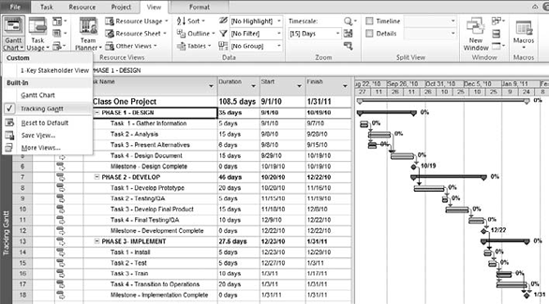After you've set the baseline—or before you
set the baseline—switch views or format the existing view to allow for
baseline data to be displayed. A typical task-based Gantt Chart view
has two sides. On the left is the table or text area, and on the right
is the bar area. Formatting one side doesn't format the other.
In other words, adding baseline fields to the table
doesn't automatically change the Gantt bars to display the baseline.
The reverse is also true: formatting the bars to display the baseline
doesn't automatically add the baseline fields to the table or text
area.
1. Tracking Gantt View and the Variance Table
Project includes predefined views and tables to
display the baseline. One such view, which is formatted to display the
baseline, is the Tracking Gantt view. Follow these steps to apply the
Tracking Gantt view (see Figure 1):
Select View tab => Task Views group => Gantt Chart drop-down list.
From the list, click Tracking Gantt.
In the Tracking Gantt view, the Gantt bars are
preformatted to display not only the baseline but also the critical
path. After you set the baseline, you'll notice two sets of bars in the
Tracking Gantt view. The bottom bars, which are gray, represent the
baseline; the top bars, which are either blue (noncritical tasks) or
red (critical tasks), represent your current plan. At first, these bars
are the same length; but as you make changes to your current plan or
record changes that are different from the baseline, the top bars move
while the bottom baseline bars remain in place—unless you reset the
baseline.

The Tracking Gantt view has the percentage complete
to the right of each bar, which is useful when you start to record
progress .
Because the Tracking Gantt view defaults to applying
the Entry table, you may find it useful to change the table to the
Variance table (see Figure 2):
it includes the Baseline Start and Baseline Finish columns along with
the Start and Finish Variance columns. Follow these steps to apply the
Variance table:
Go to View tab => Data group, and click the Tables button.
Select the Variance table.
When you set a baseline, the current Start is equal
to the Baseline Start, and the current Finish is equal to the Baseline
Finish; therefore, there is no Start or Finish Variance. This is
because when you set your baseline, Project copies whatever is in your
current plan into the baseline plan; they're exactly the same until you
make adjustments.
You can add columns in the Variance table by using Add New Column, as shown in Figure 2. This allows you to customize the table to suit your tracking needs. For example, I like to add the following:
You may find it useful to add other columns, such as Actual Start and Actual Finish, after you start recording data.
